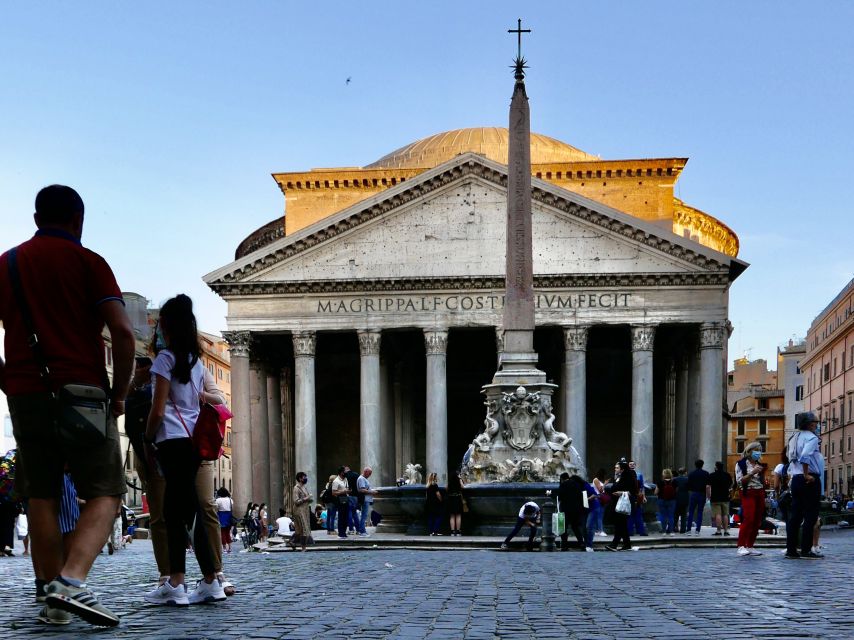
The entrance fee to the Pantheon is 5€ for 2025. The entrance to the Pantheon, which was previously free of charge, became paid in 2023 by the Italian authorities. We recommend that you visit the Pantheon with an audio guide or a professional tour guide.
The architectural form of the Pantheon, the largest and best preserved monument of Roman antiquity, is so simple that the structure has survived the hazards of the centuries almost intact.
The name of its builder is inscribed above the entrance: Marcus Agrippa, son-in-law of the Emperor Augustus, who dedicated it to the “most holy” (Greek pantheon) planetary gods – hence the dome, representing the firmament, with its opening for the sun – and not to all the gods as the name seems to imply.
The Pantheon is the place of burial of the Italian kings (Victor Emmanuel II, second niche on right; Umberto I, second niche on left); the greatest Cardinal Secretary of State of modern times, Consalvi (tomb by Thorvaldsen, 1824, third niche on left) and the great Renaissance painter Raphael (between second and third niches on left) are also buried here.

Pantheon in Rome, Italy.
The Pantheon was damaged by fire in AD. 80 and was rebuilt in the reign of Hadrian (120-125); the brickwork of this period demonstrates the extraordinarily high standard of technical mastery achieved by the Romans. In the course of the centuries the building suffered further damage and plundering: Pope Gregory III removed the gilded bronze roof-tiles, while Urban VIII used the heavy bronze roofing of the porch in the construction of Bernini’s Confessio in St Peter’s (see San Pietro in Vaticano). The building was, however, regularly restored, and also received some structural additions, since removed.
The first Christian Emperors forbade the use of this pagan temple for worship, and it remained disused until Pope Boniface IV dedicated it to the Virgin and all the Christian martyrs on 1 November 609 – the origin of the feast of All Saints.

Pantheon
From the Piazza della Rotonda, from which the Pantheon is seen hemmed in by buildings and the semicircular dome appears much flatter than it really is, steps lead down into the porch: formerly there were steps up to the entrance, but the ground level has risen considerably since then. The porch, 33 m (108 ft) wide and 13-50m (44 ft) high, has 16 granite columns with Corinthian capitals (1 2-50 m (41 ft) high, 4-50 m (15 ft) apart) and two massive ancient bronze doors.
The mighty dome of the Pantheon was the supreme achievement of Roman interior architecture. The overwhelming effect of the interior results from the harmonious proportions of the whole vast structure: the height is the same as the diameter (43-20 m – 142 ft), while the walls of the cylinder supporting the dome measure half the diameter (21-60 m-71 ft). In the walls of the cylinder (6-20 m (20 ft) thick) are semicircular and rectangular niches. The interior of the dome is coffered. The only lighting for the interior comes from a circular opening, 9 m (30 ft) wide, in the dome.

Dome of Pantheon
The restrained decoration of the interior enhances the effect of the architecture. The harmony and perfect proportions of the Pantheon – built in the image of the earth with the vault of the firmament above it – have impressed artists and visitors down the centuries. (The magnificent acoustics will be demonstrated for a small consideration.)

